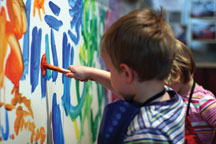
Paint Waste Disposal
The need for better environmental practices for art studios has led to the development of a new ASTM International standard, D7355, Guide for Artists' Paint Waste Disposal in Smaller Commercial or Educational Settings.
The new standard was developed by Subcommittee D01.57 on Artists' Materials, part of ASTM International Committee D01 on Paint and Related Coatings, Materials and Applications.
"The small educational setting might be allowed by law to flush their paints and brush cleaning materials down the sink, but many wanted a more responsible way to act," says Bruce Griffin, chief risk officer, University of North Carolina, Greensboro, and chairman of the task group that developed the new standard. "Manufacturers also encouraged us to continue, as they often receive requests for a ‘best disposal practice' but had no good answers."
Griffin says that D7355 gives commercial artists and art teachers in small school systems a way to deal with waste from artist paints in an environmentally friendly way. "This is especially important for those users that are too small to be regulated by laws or regulations but want to do the right thing," says Griffin.
Michael Skalka, conservation administrator, National Gallery of Art, and chairman of D01.57, says that all interested parties are invited to participate in the work of D01.57, particularly those with experience in scientific methodology, statistical analysis of data, chemistry, the working properties of paint materials, environmental testing of materials for lightfastness and other physical properties related to paint.
"Members who enjoy art and like the technical aspects of paint materials are our strongest participants and advocates," says Skalka. "We face some complicated challenges in creating standards that promote quality in art materials. Understanding technical aspects, especially for our artist/consumer members, is the most challenging part of the work of the subcommittee."
The subcommittee is currently working on standards for a variety of art materials, including acrylic primers, pastels, inkjet inks, pre-primed canvas and solid supports for paintings.
To purchase ASTM International standards, visit www.astm.org and search by the standard designation number, or contact ASTM Customer Relations (phone: 610-832-9585).
CONTACT Technical Information: Michael Skalka, National Gallery of Art • Washington, D.C. • Phone: 202-842-6439 • E-mail: m-skalka@nga.gov O ASTM Staff: Jeffrey Adkins • Phone: 610-832-9738 • E-mail: jadkins@astm.org O Upcoming Meeting: Jan. 30-Feb. 1 • January Committee Week • Baltimore, Md.
 SN Home
SN Home Archive
Archive Advertisers
Advertisers Masthead
Masthead RateCard
RateCard Subscribe
Subscribe Email Editor
Email Editor